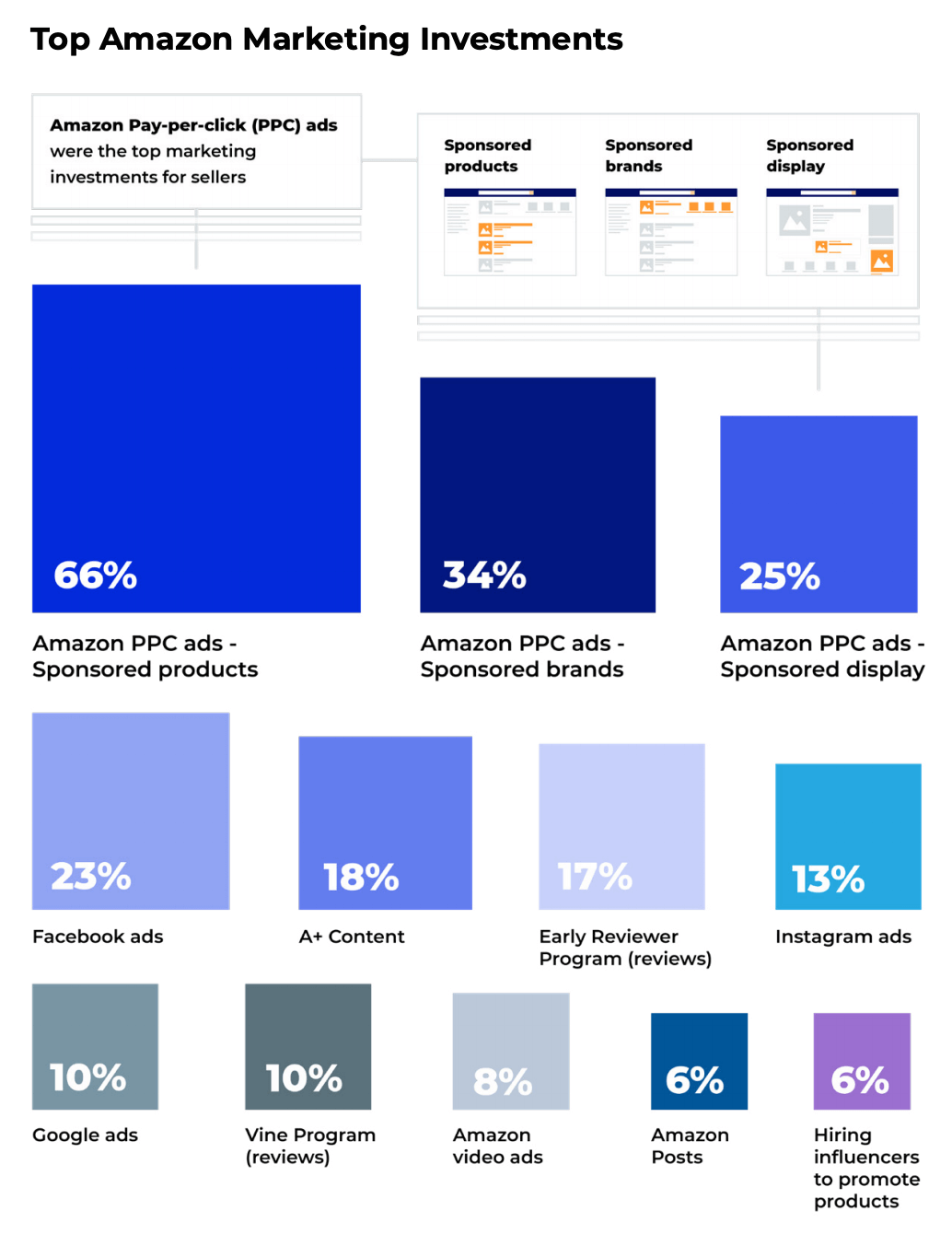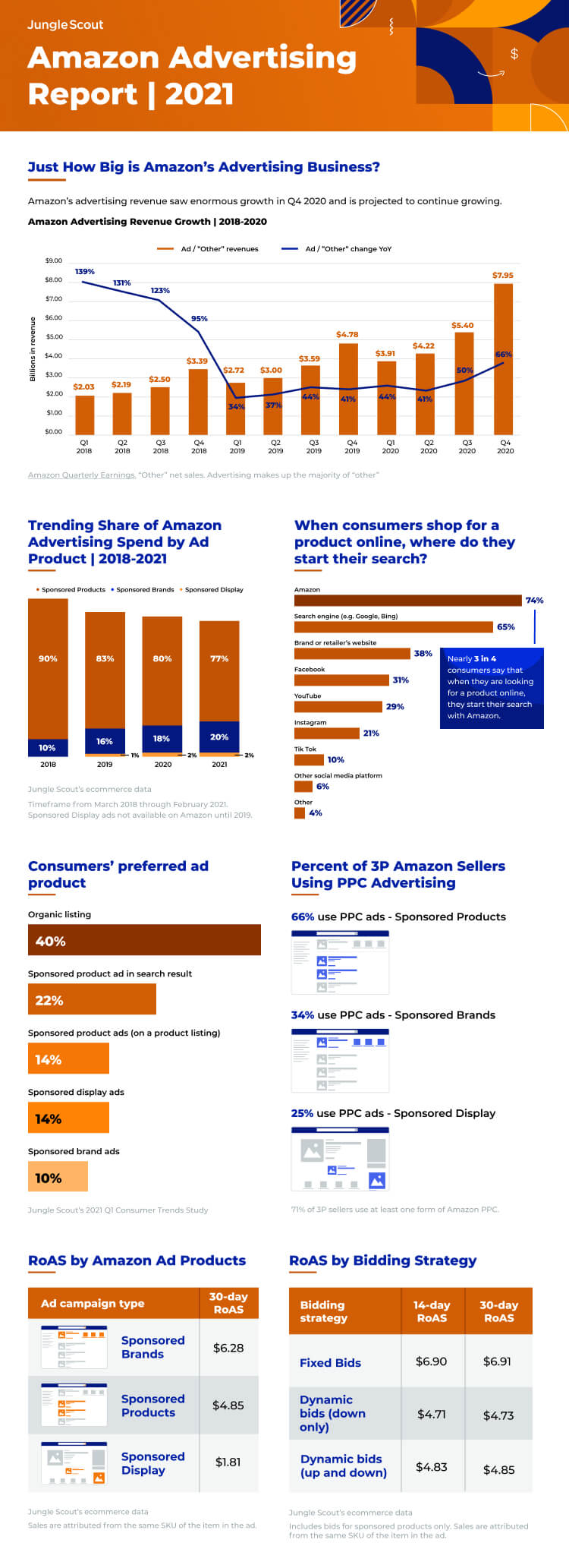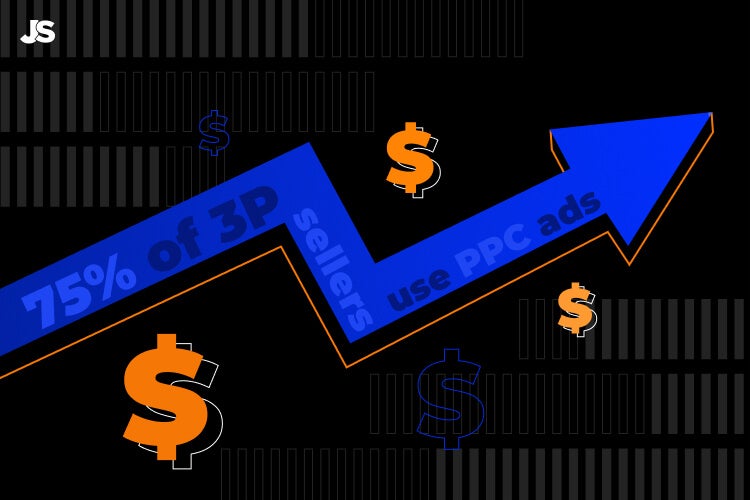It’s not just shoppers who are spending more money at the Everything Store these days. Three quarters of all Amazon sellers are spending their ad dollars on Amazon.
As the Financial Times reported, sellers’ increased marketing spend earned Amazon’s advertising business a whopping $21 billion in 2020—that’s 47% year-over-year growth. It’s enough money to elevate Amazon as a top-tier competitor in the digital ad space, edging closer to industry leaders Google and Facebook.
How exactly is Amazon’s ad business growing, and why is advertising an ever-growing need for small brands on Amazon? Jungle Scout’s data on Amazon’s third-party sellers highlights these trends.
75% of all Amazon sellers use Amazon Pay-per-Click advertising
Pay-per-click (PPC) advertising is a powerful marketing tool for Amazon sellers and a lucrative program for Amazon. As the name implies, the seller pays per click for these ads, which appear at the top of Amazon product search results, on competing product detail pages, and even other websites to retarget online window shoppers. Their on-page prominence makes them more clickable than products listed among organic search results.
PPC advertising is the most popular method used by Fulfillment by Amazon (FBA) sellers to market their products by a sizable margin. Three out of four Amazon sellers of all kinds — including 79% of first-party (1P) vendors and 71% of third-party (3P) sellers —use at least one form of Amazon PPC, and many opt for multiple.
Amazon offers three kinds of PPC ads, depending on where sellers want their ad to appear on Amazon or affiliate sites.
Of the 75% of sellers who use Amazon PPC:
- 88% use Sponsored Products
- 43% use Sponsored Brands
- 32% use Sponsored Display
On the other hand, if a seller doesn’t use PPC, it’s likely that they don’t advertise their products at all. Of the 25% of Amazon sellers who don’t run PPC ads, a handful advertise on Facebook and Youtube, but the majority (78%) say they don’t market their products on or off Amazon.
That said, only 19% of Amazon sellers overall choose not to market their products.

How PPC benefits Amazon and its sellers
Amazon’s PPC pricing structure is where things get interesting for its ad business. These cost-per-click fees aren’t flat—they fluctuate as part of an auction system in which sponsored ad placements are awarded to the highest-bidding seller.
Sellers are advised to keep their PPC bids to no more than 2.5% of their product’s selling price, which isn’t always feasible in highly competitive product niches. So while some PPC bids amount to cents on the dollar, others can reach several dollars for a single click—occasionally spiking as high as $49, as did a Sponsored Brands bid for wireless headphones.
Fortunately, an investment in PPC pays off. Sellers who use PPC are more likely to be profitable than those who don’t, and tend to achieve higher earnings. 44% of PPC users earn over $10,000 in monthly sales, versus just 20% of non-users. And 26% of PPC users have earned over $1 million in lifetime sales, compared to just 6% of PPC non-users.
Amazon is particularly popular among online shoppers, underscoring sellers’ imperative to boost awareness of their brand on the site. More U.S. consumers shopped at Amazon in 2020 than any other major retailer, including both Walmart and Target’s online stores.
Moreover, consumers’ increasing willingness to shop online throughout the pandemic is a trend that shows signs of continuing even after stores reopen.
- 70% of U.S. consumers shopped on Amazon in Q3 of 2020
- 64% of consumers say when they need a product fast, they look to see if they can buy it on Amazon first
- 74% of consumers believe the majority of shopping will happen online in the future
Given PPC’s effect on profitability, plus Amazon’s ad pricing scheme and popularity among consumers as a retail outlet, it’s easy to understand how the ad business raked in serious earnings in 2020.
Amazon’s non-PPC advertising programs are also popular
Amazon also offers sellers paid marketing programs beyond PPC. Prices for participating in these programs vary—Amazon may charge an enrollment fee or ask the seller to cover the cost of the products it sends to vetted reviewers. Some programs are restricted to brand-registered sellers (a title that incurs its own set of costs).
Amazon’s non-PPC advertising programs
Percent of Amazon sellers
A+ Content
18%
Early Reviewer Program (reviews)
17%
Vine Program (reviews)
10%
Amazon video ads
8%
Amazon Posts
6%
Amazon Live
2%
Amazon Editorial Recommendations
1%
Amazon warmed up to video-based marketing in 2020, allowing sellers to upload short clips to their listings and live-stream to potential customers. Given that 71% of online shoppers are influenced by photos or videos on a product listing, Amazon’s ad business is likely to benefit from expanded video content.
At least 23% of sellers market their products off Amazon
In addition to (or in lieu of) Amazon PPC, sellers are diversifying their marketing portfolio to social channels like Facebook or Instagram. Sellers know it’s important to build interest outside of Amazon itself. After all, 57% of U.S. consumers say they’ve purchased a product online that they first learned about through social media.
Top Social Media Marketing Platform for Amazon Sellers
Social Media Platform
Percent of Amazon sellers
Facebook
23%
Instagram
13%
Pinterest
4%
Tik Tok
2%
Youtube (general)
4%
My own Youtube channel
3%
While Amazon’s ad business doesn’t profit directly from sellers’ ad spending on other sites, off-Amazon marketing draws in ever more consumers to its marketplace.
For sellers, advertising is a challenge and a priority
More sellers on Amazon means more competition, and greater need for optimized marketing strategies. It’s no longer enough for a seller to offer a great product—they need to get as many eyes on their listing as possible in order to stand out in a sea of comparable items.
Running PPC campaigns is a popular—if often difficult—solution. Among sellers who use at least one form of Amazon PPC, 51% say it’s challenging to manage.
When asked what would make them more successful at managing PPC, sellers list training, experience, and the ability to automate their PPC operations. To some sellers, PPC seems “very complex,” and regard branding as an aspect of their business that “seems to require a larger team or an agency” to master.
Challenges aside, sellers strive to make their products highly visible to consumers in the ever-growing ecommerce industry. Many are taking steps to be more competitive by boosting their digital marketing skills on and off Amazon in 2021.
- 32% of all sellers say the ability to effectively use PPC contributes to their success on Amazon
- 43% are currently focusing their efforts on managing PPC
- 34% plan to spend more on strategic advertising, including PPC, in 2021
- 32% plan to grow their brand via social media, influencer marketing, and other off-Amazon marketing efforts
Sellers who commit to mastering PPC are better off than those who don’t. As the marketplace gets more competitive, this gap may widen.
Predicting future growth for Amazon’s ad business
The popularity of online shopping—and shopping on Amazon, specifically—is likely to stick around even after it becomes safe to pack brick-and-mortar stores to pre-COVID capacity. Accordingly, Amazon sellers will have to jockey for ad space with their existing competitors, plus those projected to join them in the coming years.
Consumers’ preference for Amazon, PPC’s performance-enhancing effects, and Amazon’s continued expansion of its non-PPC ad programs all bode well for its ad business growth in 2021.
For more information on how shifting norms in consumer spending impact Amazon sellers, check out our Consumer Trends Report.
Sellers interested in optimizing their PPC spend can read our guide to Amazon PPC strategies, updated for 2022.
For an in-depth look at how agencies, brands, and sellers use Amazon advertising strategies to compete in the world’s largest ecommerce marketplace, see our Amazon Advertising Report for 2021. Some key insights from the report are shown below.


 No Comments
No Comments